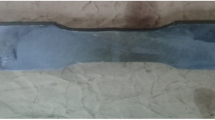Abstract
In this research work, aluminium with low-carbon steel was joined through the explosive welding process at different loading ratios. The high impact pressure caused by explosive energy at the weld interface results in increase in hardness value. This hardness property plays an important role, as it affects the mechanical properties of welded plates. A model based on an intelligent technique named adaptive network-based fuzzy inference system (ANFIS) has been developed to predict the various micro-hardness values across the weld interface of explosive welded plates. The obtained experimental data were utilized for training and testing of the ANFIS model to predict micro-hardness values. The developed model was used on both sides of the weld interface, i.e. aluminium and steel. The model performance evaluations were carried out using different statistical criteria such as cross-correlation, mean absolute percentage error (MAPE) and root-mean-square error (RMSE). In comparison with aluminium, the steel side showed good results with a value of adj. R-square (0.95955) when compared to that in aluminium (0.85343). This observation was also supported by MAPE and RMSE data. The experimentally obtained micro-hardness values were found to be in good agreement with predicted ones through the ANFIS model.










Similar content being viewed by others
References
Findik F, Mater Des32 (2011) 1081.
Carvalho G H S F L, Galvão I, Mendes R, Leal R M, and Loureiro A, Mater Charact155 (2019) 109819.
Chen J, Yuan X, Hu Z, Li T, Wu K, and Li C, J Manuf Process30 (2017) 396.
Qiu R, Iwamoto C, and Satonaka S, J Mater Process Technol209 (2009) 4186.
Yu H, Dang H, and Qiu Y, J Mater Process Technol250 (2017) 297.
Yu H, and Tong Y, Int J Adv Manuf Technol91 (2017) 2257.
Crossland B, McKee F, and Szecket A, in High-Pressure Science and Technology, Springer, Berlin (1979), p 1837.
Sherpa B B, Kumar P D, Upadhyay A, Batra U, and Agarwal A, Adv Appl Phys Chem Sci Sustain Approach (2014) 33.
Acarer M, Gülenç B, and Findik F, Mater Des24 (2003) 659.
Kahraman N, Gülenç B, and Findik F, J Mater Process Technol169 (2005) 127.
Kim D, Rhee S, and Park H, Int J Prod Res40 (2002) 1699.
Singh S B, Bhadeshia H K D H, MacKay D J C, Carey H, and Martin I, Ironmak Steelmak25 (1998) 355.
Almonacid F, Fernandez E F, Mellit A, and Kalogirou S, Renew Sustain Energy Rev75 (2017) 938.
Kim I S, Son J S, Lee S H, and Yarlagadda P K, Robot Comput Integr Manuf20 (2004) 57.
Anand K, Barik B K, Tamilmannan K, and Sathiya P, Eng Sci Technol Int J18 (2015) 394.
Gupta S K, Pandey K, and Kumar R, Proc Inst Mech Eng Part L J Mater Des Appl232 (2018) 333.
Ross T J, Fuzzy Logic with Engineering Applications, Wiley, Hoboken (2005).
Yetilmezsoy K, Erhuy C G, Ates F, and Bilgin M B, J Braz Soc Mech Sci Eng40 (2018) 283.
Kuo H-C, and Wu L-J, J Mater Process Technol120 (2002) 169.
Naso D, Turchiano B, and Pantaleo P, IEEE Trans Ind Inf1 (2005) 259.
Aghakhani M, Ghaderi M R, Karami A, and Derakhshan A A, Int J Adv Manuf Technol70 (2014) 63.
Wang L-X, in IEEE International Conference on Fuzzy Systems, IEEE (1992).
Avci E, Appl Soft Comput8 (2008) 225.
Jang J-S, IEEE Trans Syst Man Cybern23 (1993) 665.
Ying L-C, and Pan M-C, Energy Convers Manag49 (2008) 205.
Lin C-T, Lee C S G, IEEE Trans Comput 40 (1991) 1320.
Buragohain M, and Mahanta C, Appl Soft Comput8 (2008) 609.
Kahraman N, and Gülenç B, J Mater Process Technol169 (2005) 67.
Mousavi S A, and Sartangi P F, Mater Des30 (2009) 459.
Gloc M, Wachowski M, Plocinski T, and Kurzydlowski K J, J Alloys Compd671 (2016) 446.
Chen P, Feng J, Zhou Q, An E, Li J, Yuan Y, and Ou S, J Mater Eng Perform25 (2016) 2635.
Xia H-B, Wang S-G, Ben H-F, Mater Des 1980–201556 (2014) 1014.
Karakus M, and Tutmez B, Rock Mech Rock Eng39 (2006) 45.
SinghT N, Kanchan R, Verma A K, and Saigal K, J Earth Syst Sci114 (2005) 75.
Dewan M W, Huggett D J, Liao T W, Wahab M A, and Okeil A M, Mater Des92 (2016) 288.
Singh R, Kainthola A, and Singh T, Appl Soft Comput12 (2012) 40.
Tzamos S, and Sofianos A, Int J R Mech Min Sci43 (2006) 938.
Acknowledgements
The support from the Terminal Ballistics Research Laboratory is highly acknowledged. The authors are very thankful to Dr. Manjit Singh, Director, TBRL, sector-30 Chandigarh. Thanks also go to all the scientists and staff of MEMWD and EED of TBRL for their valuable support.
Author information
Authors and Affiliations
Corresponding author
Additional information
Publisher's Note
Springer Nature remains neutral with regard to jurisdictional claims in published maps and institutional affiliations.
Rights and permissions
About this article
Cite this article
Sherpa, B.B., Kumar, P.D., Upadhyay, A. et al. Neuro-Fuzzy Technique for Micro-hardness Evaluation of Explosive Welded Joints. Trans Indian Inst Met 73, 1287–1299 (2020). https://doi.org/10.1007/s12666-020-01980-2
Received:
Accepted:
Published:
Issue Date:
DOI: https://doi.org/10.1007/s12666-020-01980-2




